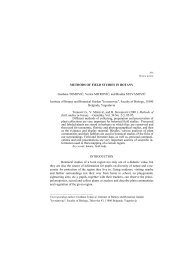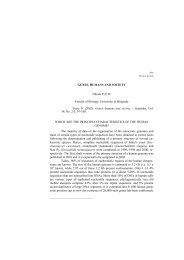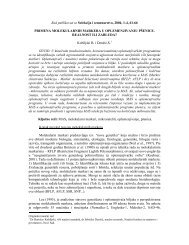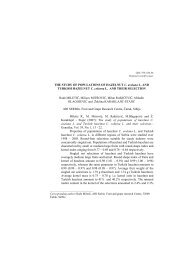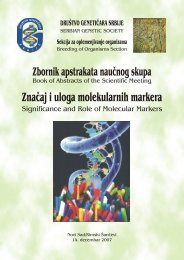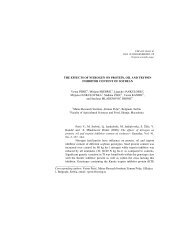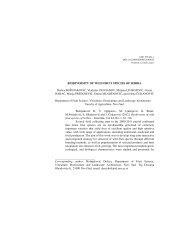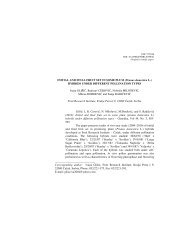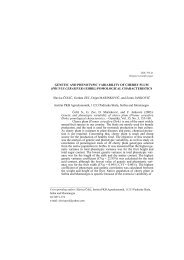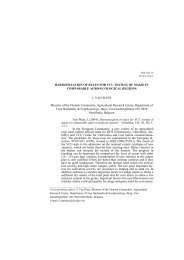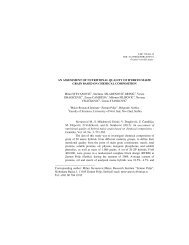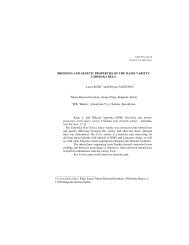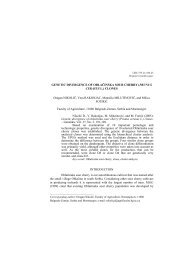Zbornik - Društvo genetičara Srbije
Zbornik - Društvo genetičara Srbije
Zbornik - Društvo genetičara Srbije
Create successful ePaper yourself
Turn your PDF publications into a flip-book with our unique Google optimized e-Paper software.
6 ZBORNIK ABSTRAKATA III KONGRESA GENETIÈARA SRBIJE<br />
Subotica, 30. novembar - 4. decembar 2004.<br />
Uvodno<br />
predavanje<br />
VEŠTAÈKI HROMOZOM BAZIRAN NA SATELITSKOJ DNK<br />
Gyula Hadlaczky<br />
Institute of Genetics, Biological Research Center, Hungarian Academy of Sciences, Szeged, Hungary<br />
In vivo konstrukcija animalnog veštaèkog hromozoma pretstavlja ponovljivu i efikasnu<br />
tehnologiju za konstrukciju stabilnog veštaèkog hromozoma baziranog na satelitskoj<br />
DNK (SATACs – Stable satelite DNA-based Artificial Chromosomes) definisanog<br />
genetièkog sadraja. SATAC tehnologija se bazira na indukciji de novo formiranja<br />
hromozoma amplifikacijom na velikoj skali, koja moe da se inicira ciljnom integracijom<br />
strane DNK u satelit/rDNK region hromozoma domaæina. Ko-amplifikacija sekvenci<br />
integracionog mesta ima kao rezultat de novo formiranje hromozomskih krakova i nove<br />
hromozome koji imaju sekvence satelitske rDNK i egzogene DNK. SATACssu<br />
heterohromatinski, ali obezbeðuju pogodnu hromozomalnu okolinu za stabilnu, trajnu<br />
ekspresiju integrisanog genetièkog materijala.<br />
SATACs mogu biti konstruisani, preèišæeni i preneseni u æeliju – primaoca ukljuèujuæi<br />
oploðenu jajnu æeliju. Transgene ivotinje su uspešno kreirane preèišæenim SATACs i<br />
utvrðena je vertikalna transmisija Zbog osnovne sliènosti elementarnih mehanizama u<br />
æelijama eukariota, SATAC tehnologija moe da se uspešno primeni kod razlièitih vrsta,<br />
ukljuèujuæi ljudske, animalne i biljne æelije za in vivo konstrukciju veštaèkog hromozoma<br />
sa odabranim sekvencama.<br />
SATELLITE DNA-BASED ARTIFICIAL CHROMOSOMES<br />
In vivo generation of mammalian artificial chromosomes represents a reproducible and<br />
efficient technology for construction of stable satellite DNA-based artificial chromosomes<br />
(SATACs) with defined genetic content.<br />
SATAC technology is based on the induction of de novo chromosome formations via<br />
large-scale amplification, which can be initiated by targeted integration of exogenous<br />
DNA into the satellite/rDNA region of host chromosomes. Co-amplification of sequences<br />
of the integration site results in de novo formed chromosome arms and new<br />
chromosomes that composed of exogenous DNA and satellite/rDNA sequences.<br />
SATACs are heterochromatic, however, they provide a suitable chromosomal environment<br />
for stable, persisting expression of the integrated exogenous genetic material.<br />
SATACs can be engineered, purified and transferred into recipient cells including fertilized<br />
eggs. Transgenic animals have successfully been generated with purified SATACs,<br />
and the transmission of artificial chromosome through generations has been demonstrated.<br />
Because of the basic similarities of the intrinsic cellular mechanisms between<br />
eukaryotes, SATAC technology can successfully be applied in different species including<br />
human, animal, and plant cells for in vivo construction of satellite DNA based artificial<br />
chromosomes from predictable sequences.<br />
Due to the rapid development of SATAC technology, by the development of the Artificial<br />
Chromosome Expression System, the feasibility of the use of satellite DNA-based<br />
artificial chromosome has been established, in different fields of gene technology. Second<br />
generation artificial chromosomes represent a novel protein production platform<br />
both for cellular protein production and for production of therapeutic molecules in body<br />
fluids of transgenic animals; for development of transgenic animals with genetically<br />
modified (humanized) tissues and organs for xenotransplantation. Also, stable SATACs<br />
with practically unlimited carrying capacity may serve as potential vectors for animal<br />
breeding, and for human gene therapy.



